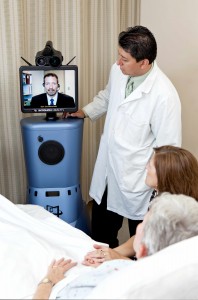-
Minnesota
Telemedicine & You: Mayo Clinic Expert Explains New Health Care Option, How State and National Policies Can Catch Up

Rochester, Minn. — If you haven’t already experienced telemedicine, you may soon have the option. Technology is helping people connect with their physicians in new ways and from a distance, and interest is growing in updating state and federal policies to help make telemedicine available to more patients.
Mayo Clinic this week responded to a request from the House Energy and Commerce Committee for recommendations on how lawmakers can help this new health care option progress. Steve Ommen, M.D., medical director of Mayo Clinic Connected Care, explains telemedicine and outlines state and national moves that would help more patients take advantage of it:
What is telemedicine? Telemedicine most commonly refers to communication with or among a patient’s health care team via video connection, secure text messaging or another platform rather than in person. It can be used to schedule appointments, answer questions, handle routine checkups, allow physicians in different locations to consult about a patient’s case, collect vital signs or even to help examine and diagnose patients. To protect patient privacy, secure communication methods are used.
Mayo Clinic views development of telemedicine as an important next step to improve health care access, quality and efficiency across the country.
MEDIA CONTACT: Sharon Theimer, Mayo Clinic Public Affairs, 507-284-5005, Email: newsbureau@mayo.edu
Journalists: Sound bites with Dr. Ommen are available in the downloads.
“I think of telemedicine as using technology to meet the needs of patients where they are rather than making them come to where we are,” says Dr. Ommen, a Mayo Clinic cardiologist. “There are a lot of things we do in medicine that do not require face-to-face interactions, and we can use technology to meet those needs: prescription refills, or simply exchanging information about how it’s gone since your last visit, for example. A lot of that information can be exchanged electronically in a way that makes it much more convenient for the patient and for the doctor.”
Telemedicine initially developed as a way to provide complex specialty care to rural patients whose local hospitals didn’t have specialists available. For example, Mayo Clinic uses telestroke robots to help swiftly diagnose stroke patients whose hospitals do not have neurologists on hand around the clock as Mayo does. A robot at the patient’s hospital allows Mayo neurologists to perform live, real-time audiovisual consultations with the patient and emergency medicine physicians at his or her hospital; speedy delivery of clot-busting drugs is crucial to halt and reverse stroke damage.
Now, telemedicine can help patients and health care organizations wherever they are: Other telemedicine options offered by Mayo include robots on the sidelines at football games to help diagnose concussions; a pilot program offering private workplace kiosks where people can be treated for minor health problems without leaving work; secure messaging, electronic and video consults; eDelivery rooms that use video and tablets to connect Mayo Clinic Health System delivery rooms to neonatologists at Mayo Clinic; and remote intensive care unit monitoring to support ICU teams at smaller hospitals.
Why are policy changes needed? Telemedicine technology is developing rapidly, but there are policy barriers holding back its use, Dr. Ommen says.
“The policies really haven’t kept up, but there is certainly interest at both the state and national level in updating them,” Dr. Ommen says.
In the letter to the House Energy and Commerce Committee, Mayo Clinic proposals include:
- Lifting geographic restrictions on Medicare reimbursement that only pay for telemedicine services if a patient is located in a rural and/or medically underserved community. Telemedicine can benefit people in metropolitan areas as well, Dr. Ommen says.
“Personal mobility can be an issue. For example, for someone with orthopedic problems, it’s not driving down the highway that’s a problem; it’s getting out to the car that’s even more of a hassle,” Dr. Ommen says. Telemedicine can also help people avoid having to take time off work or drive across a large metropolitan area to go to a doctor’s office, he says.
“Telemedicine is for everyone. Everyone can benefit from getting more rapid access and more convenient access to their health care providers,” Dr. Ommen says. “Limiting it to people who are in rural or medically underserved areas limits the potential of telemedicine.”
- Supporting multistate medical licensing compacts, and possibly creating national physician licensing like Veterans Administration physicians have, to make it easier to license physicians who practice in multiple states. Currently, a physician providing telemedicine services must be licensed in the state where the patient lives, a costly and and time-consuming process.
“We’re seeing state medical societies as well as the American Medical Association endorsing this idea of the state compacts to improve that situation,” Dr. Ommen says.
- Promoting pilot projects on innovative telemedicine delivery platforms and incorporating successful models into the health care options available for patients of all ages.
Mayo’s comments to House Energy and Commerce follow a Senate Aging Committee roundtable event last September on telemedicine, including its possibilities and the challenges facing its growth.
“There was almost unanimity in the room that the current legislative barriers were real barriers that needed to change,” says Dr. Ommen, who spoke at the Senate event . “My hope is that the discussion will grow, and we could start seeing legislation as early as this Congress.”
Besides convenience, what are some of the other benefits of telemedicine? Mayo research has found that in addition to providing convenient, high-quality care, telemedicine can save money.
For example, Mayo studies on telestroke found that, compared with hospitals without a telestroke network, telestroke systems resulted in the use of appropriate advanced therapies that in turn allowed more patients to return home rather than requiring nursing home care.
“I see telemedicine as really extending the relationship a person already has with their providers,” Dr. Ommen says. “It provides new options for reaching them more urgently and more conveniently. It’s a choice that patients and providers can make to be in better contact with one another.”
To request an interview with Dr. Ommen, please contact Sharon Theimer in Mayo Clinic Public Affairs at 507-284-5005 or newsbureau@mayo.edu.
###
About Mayo Clinic
Mayo Clinic is a nonprofit organization committed to medical research and education, and providing expert, whole-person care to everyone who needs healing. For more information, visit http://www.mayoclinic.org/about-mayo-clinic or https://newsnetwork.mayoclinic.org/.







